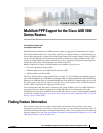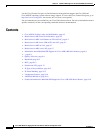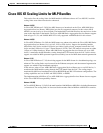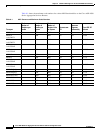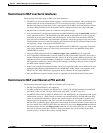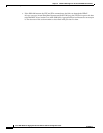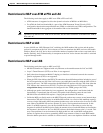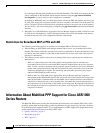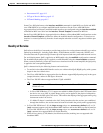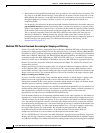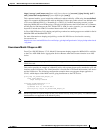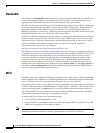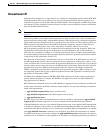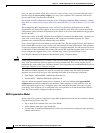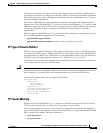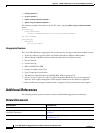
8-9
Cisco ASR 1000 Series Aggregation Services Routers Software Configuration Guide
OL-16506-17
Chapter 8 Multilink PPP Support for the Cisco ASR 1000 Series Routers
Information About Multilink PPP Support for Cisco ASR 1000 Series Routers
• Downstream LFI, page 8-13
• IP Type of Service Reflect, page 8-15
• IP Tunnel Marking, page 8-15
Some Cisco IOS platforms use the interface multilink command for both MLP over Serial and MLP
over ATM (MLPoA) to configure multilink bundle interfaces. On the Cisco ASR 1000 Series
Aggregation Services Routers, multilink bundle interfaces are configured using the interface multilink
command for MLP over Serial and the interface Virtual-Template command for MLPoA.
On the Cisco ASR 1000 Series Aggregation Services Routers, all broadband MLP configurations use the
interface Virtual-Template command to define the multilink bundle configuration. A virtual access
interface is created dynamically from the virtual template when the session is negotiated with the peer
device.
Quality of Service
QoS refers to the ability of a network to provide improved service to selected network traffic over various
underlying technologies, including Frame Relay, ATM, Ethernet and 802.1 networks, SONET, and
IP-routed networks. In particular, QoS features provide improved and more predictable network service.
For serial deployments, QoS is applied to an MLP bundle using the multilink configuration command.
For broadband deployments, QoS is applied to an MLP bundle using the virtual-template command.
When a router dynamically creates the virtual access interface from the virtual template, the QoS policy
is applied to the corresponding bundle.
QoS is characterized by the following features and restrictions:
• To rate limit a broadband MLP bundle session, use a hierarchical QoS (HQoS) policy with a parent
shaper in the class-default class.
• The Cisco ASR 1000 Series Aggregation Services Routers support HQoS queuing only in the egress
(output) direction, and not in the ingress direction.
• The Cisco IOS XE software supports Model-F QoS with MLP.
Note Model-F QoS on the L2TP tunnel is not supported on the Cisco ASR 1002-X Router and the
FP100 line card.
–
In Cisco IOS XE Release 3.7.1S, support was added for Model-F QoS on the L2TP tunnel when
the device acts as an LNS. A parent shaper policy can be applied to the physical subinterface
that connects the LNS to the LAC device. This enables the shaping of the aggregate traffic going
downstream to the LAC device.
–
If a Model-F shaper is attached to the LAC-facing interface after the sessions are established
through that interface, the sessions must be bounced to handle the priority traffic appropriately.
• In Cisco IOS XE Release 3.4S, the shape average shape-rate account user-defined <-63 to 63>
[atm] command supports only the broadband MLP interface and not the MLP over Serial interface.
In Cisco IOS XE Release 3.6S, the shape average shape-rate account user-defined <-63 to 63>
[atm] command also supports MLP over Serial Interface.
• ATM cell loss priority (CLP) Match (classification) and Set (marking) are not supported with
broadband MLP.



